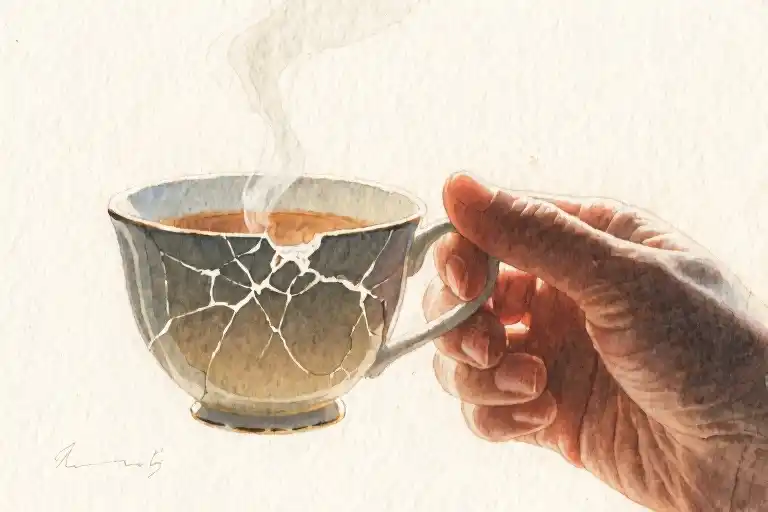The leather belt’s creak still echoes in your bones. That specific rhythm of footsteps down the hallway—you could diagram the exact number between the third floorboard squeak and the armoire door’s metallic whine. These weren’t childhood games. They were survival algorithms coded into your nervous system before you could spell ‘safety’.
Trauma rewires perception. Where others see ordinary spaces, you’ve always navigated minefields. The shoes positioned for quick escape near your childhood bed now manifest as triple-checked door locks and memorized emergency exits. Your colleagues call it “attention to detail” when you predict meeting tensions before the first coffee sip. They don’t realize you’re reading microexpressions with the same precision that once tracked parental mood swings.
This isn’t paranoia. It’s your brilliant, battered brain doing exactly what evolution designed it to do—protect you. The amygdala doesn’t care that you’re now thirty and financially independent. It still fires alerts when it detects patterns matching past danger: a raised voice with that particular timbre, sudden movements in peripheral vision, certain tones of silence. These physiological reactions kept you alive. The problem isn’t your survival instincts—it’s that they’re now responding to false positives in a world that’s statistically safer than your childhood.
Consider the bedtime shoe ritual. As a child, having footwear within reach meant you could flee nighttime violence. Today, that same hypervigilance might leave you exhausted from scanning harmless noises. The very skills that protected you—environmental scanning, emotional forecasting, crisis rehearsals—now drain energy better spent on living rather than surviving.
Yet there’s profound intelligence in these adaptations. Your ability to detect subtle emotional shifts? That’s an exquisite radar system. Your capacity to endure discomfort? Emotional stamina few possess. The challenge lies not in erasing these traits, but in retraining them—shifting from constant threat assessment to intentional awareness. Later sections will explore how to convert your defensive algorithms into creative superpowers. For now, simply notice: what your mind labeled as brokenness was actually brilliance under impossible circumstances.
Your body remembers what your conscious mind tries to forget. The tightness in your chest when hearing particular phrases isn’t weakness—it’s somatic bookmarks your nervous system created to protect you. Healing begins when we stop fighting these reactions and start deciphering their origin codes. Those midnight footsteps you counted weren’t just sounds—they were data points in your personal safety equation. Honor that younger self who became an expert in patterns no child should have to study.
The Museum of Body Memory
Your body keeps score in ways your conscious mind has long forgotten. That subtle tension in your shoulders when a door slams too loudly isn’t random—it’s an archived response from years of decoding danger signals. These physiological records form what trauma specialists call body memory, an intricate filing system where survival instincts outlast their original context.
Auditory Archives: The Biology of Danger Decoding
Most people hear footsteps. You hear patterns—the rhythm of soles against floorboards that once predicted storms. Your ears became precision instruments, calibrating to frequencies most would dismiss as background noise. That split-second freeze when a coworker’s gait echoes too closely down the hallway? That’s your ancient brain cross-referencing new inputs with old threat databases.
Neuroscience explains this through sensory gating, where trauma survivors develop hypersensitive auditory filtering. While others’ brains dampen repetitive sounds, yours remains on high alert—a biological inheritance from when missing a cue could mean catastrophe. The irony? This skill that once protected you now hijacks boardroom meetings and coffee dates, mistaking ordinary life for minefields.
Tactile Exhibits: Leather and the Freeze Response
Fingers remember what minds try to forget. Run yours along a certain texture—maybe the strap of a handbag or a car’s interior—and suddenly you’re twelve again, measuring the distance to the nearest exit. Tactile memories bypass rational thought, triggering full-body reactions before your prefrontal cortex can intervene.
This isn’t psychological weakness but somatic intelligence. Your nerve endings developed early warning systems, associating specific textures with imminent threat. Modern trauma therapy recognizes these physical imprints as body maps—literal pathways where past experiences etch themselves onto muscle and skin.
The Office as Survival Terrain
Watch how you enter rooms today. That micro-pause at thresholds, the quick scan for exits and expressions—these are wilderness survival tactics transplanted into corporate spaces. Your brain still operates on perimeter security protocols, treating watercooler chats like reconnaissance missions.
What feels like social anxiety is actually hypervigilance repurposed—a system designed for physical safety now applied to emotional risk assessment. You read micro-expressions with forensic precision because missing a frown once meant trouble. The cost? Your nervous system pays in cortisol what your ancestors paid in adrenaline, exhausting itself by treating PowerPoint presentations like predator encounters.
The path forward isn’t about erasing these reflexes but recontextualizing them. Those finely-tuned senses? They’re the foundation of exceptional emotional intelligence. That rapid threat assessment? It’s strategic thinking in its purest form. Your body didn’t betray you by remembering—it loved you enough to keep you alive. Now it’s learning a new definition of safety, one where most footsteps are just footsteps, most leather is just leather, and rooms are places to inhabit rather than survive.
The Survivor’s Skill Tree: When Protection Becomes Prison
We don’t talk enough about the strange gifts that grow in the shadow of trauma. Those hyper-alert senses that kept you safe as a child—the way you could predict a mood shift from the slightest creak of floorboards, or translate silence into precise emotional weather reports—they’re not flaws. They’re sophisticated survival mechanisms written into your nervous system through repetition and necessity.
The unexpected competencies emerge quietly. You might notice them first in unrelated situations—how you’re always the first to sense tension in a meeting before anyone speaks, or how you instinctively position yourself near exits in crowded rooms. These aren’t paranoid behaviors; they’re the residual artifacts of a brain that mastered threat detection before it learned algebra.
Three branches of this skill tree prove particularly common among trauma adapters:
Crisis forecasting turns your amygdala into a supercomputer running constant risk assessments. You develop an uncanny ability to anticipate problems three moves ahead, spotting potential disasters in ordinary scenarios. While colleagues marvel at your ‘intuition,’ they don’t see the exhausting background processes—the perpetual simulation of worst-case scenarios your mind automatically generates.
Micro-expression fluency makes you a human polygraph machine. Years of studying subtle facial tics, vocal fluctuations, and posture shifts gift you with near-forensic abilities to detect unspoken emotions. This talent serves well in negotiation or caregiving roles, but comes with a hidden tax: the inability to turn off this scanning even during casual conversations, leaving you perpetually drained.
Silence deciphering, perhaps the most poetically painful adaptation, transforms you into a scholar of negative space. You learn to measure the weight of unsaid words, to distinguish between comfortable quiet and dangerous stillness. This skill breeds profound listeners and artists, but also people who struggle to trust straightforward communication.
The shadow side of these strengths reveals itself slowly. That brilliant threat-detection system? It consumes glucose and mental bandwidth like a luxury car guzzles fuel. The emotional radar? It often picks up signals others intentionally broadcast, not just the subconscious leaks. And while these skills protected you during active danger, their constant operation in safer environments creates new vulnerabilities—compromised immune function from chronic stress, difficulty enjoying mundane moments, relationships strained by over-interpretation.
Yet neuroplasticity offers escape routes. Research identifies three optimal windows for rewiring these patterns: during major life transitions (when old neural pathways destabilize), through targeted somatic therapies (working with body memories directly), and in deliberately created safe relationships (where new attachment templates can form). The very adaptability that encoded these survival skills now becomes the mechanism for their transformation.
The alchemy lies in redirecting these hard-earned abilities without discarding them entirely. That micro-expression expertise becomes professional empathy when channeled into counseling. The crisis forecasting morphs into strategic planning talents for projects. The silence reading transforms into poetic sensitivity. What once served as armor gradually reshapes itself into tools—still yours, but no longer weighing you down.
This metamorphosis doesn’t require forgetting your history or pretending the adaptations were worthless. It simply asks one radical question: ‘How might these skills serve me differently now that I’m no longer that child in danger?’ The answers arrive slowly, like sunlight finding its way through persistent cloud cover.
Reclaiming Your Space: A Practical Guide to Safety
Your body remembers things your mind has tried to forget. The way you still arrange furniture to maintain clear exit paths, how you instinctively note the nearest bathroom in any new environment, or why you feel that subtle tension when someone stands too close to your workspace. These aren’t quirks – they’re the architectural blueprints your nervous system drafted during years of survival mode.
Redefining Safe Distances
Start small with what trauma expert Peter Levine calls ‘boundary experiments.’ That pair of shoes you’ve kept by your bed since childhood? Try moving them three feet farther away tonight. Not across the room, not out of sight – just enough to notice your body’s reaction without overwhelming it. Observe the physical sensations that arise: maybe your breath shallows, your shoulders tense. Sit with those feelings for ninety seconds (the average duration of an emotion wave) while whispering to yourself: ‘I’m an adult now. I choose where my shoes go.’
Many survivors discover their perceived ‘safety radius’ shrinks over time with consistent practice. A client who once needed visual confirmation of all exits in a restaurant now comfortably sits anywhere after six months of gradual exposure. The key lies in respecting your current capacity while gently expanding it – like training muscles without tearing tendons.
The 15% Challenge
Neuroscience reveals we rewire fear responses through what’s called ‘optimal anxiety’ – situations just slightly beyond our comfort zone. Therapist David Baldwin suggests the 15% rule: each week, expose yourself to one scenario that feels 15% less guarded than usual. This could mean:
- Leaving your phone in another room for twenty minutes
- Sitting with your back to a café door
- Sharing a minor preference you’d normally suppress (‘I’d rather see the comedy movie’)
Keep a log tracking physical reactions before, during, and after these experiments. Over time, you’ll likely notice your threat detection system calibrating – fewer false alarms, quicker return to baseline. One trauma survivor described it as ‘downgrading from missile defense software to a thoughtful neighborhood watch.’
Retiring Your Internal Sentry
Chronic hypervigilance operates like an overworked security guard scanning for threats that rarely materialize. Begin giving this exhausted part of you scheduled breaks through somatic exercises:
- The 4-7-8 Reset: Inhale for 4 counts, hold for 7, exhale for 8. This activates the parasympathetic nervous system directly counteracting fight-or-flight mode.
- Gravity Check: Lie on the floor (yes, like a toddler having a meltdown) and notice where your body makes contact with the ground. The physical pressure stimulates proprioception, helping override panic signals.
- Environmental Rescan: Consciously catalog non-threatening elements in your surroundings – the hum of appliances, the texture of upholstery. This redirects threat-focused attention.
Many find these practices work cumulatively. A former client reported: ‘After three months of daily gravity checks, I realized I’d stopped holding my breath when hearing footsteps in my apartment building.’
Remember, these aren’t about eliminating caution but restoring choice. The goal isn’t to walk through life unaware, but to decide when and where your protective mechanisms serve you – rather than the ghosts of your past.
When Survival Skills Become Creative Superpowers
The same hypervigilance that once kept you scanning rooms for danger can evolve into an extraordinary ability to notice subtle emotional shifts in others. Many trauma survivors discover their heightened sensitivity – initially developed as a defense mechanism – becomes their greatest creative asset when consciously redirected.
Writers who grew up anticipating moods often develop an almost musical ear for language rhythms and subtext. Their brains, trained to decode unspoken tensions, excel at crafting layered metaphors that resonate with readers’ unconscious experiences. One novelist describes her process: “Tracking my father’s unpredictable anger gave me a radar for emotional truth. Now I use it to find the precise words that make readers feel understood.”
Therapists with trauma histories frequently develop innovative approaches precisely because traditional methods failed them. Their lived experience of emotional survival allows them to recognize gaps in conventional therapy models. A psychologist specializing in complex PTSD treatment explains: “My childhood ‘research’ in de-escalation tactics led me to develop somatic interventions years before they became mainstream. Clients say they trust me because they sense I truly know what hiding in a closet feels like.”
Even seemingly maladaptive traits like compulsive checking can transform into professional strengths. Software engineers with trauma backgrounds often demonstrate unparalleled attention to edge cases and system vulnerabilities. “My brain automatically generates ‘what-if’ disaster scenarios,” admits a senior developer at a cybersecurity firm. “Where others see paranoia, my team sees thoroughness. I’ve caught critical bugs because my nervous system still remembers how quickly safety can disappear.”
These transformations don’t happen automatically. They require consciously separating the skill from the fear that originally powered it. The writer had to stop viewing her observational abilities as tools for preventing attacks and start seeing them as instruments for connection. The therapist needed to reframe her childhood hyperawareness not as a symptom but as specialized training. The programmer learned to harness his catastrophic thinking without being consumed by it.
This alchemy of trauma involves three stages: recognition (naming your survival skills), reclamation (acknowledging their value beyond protection), and redirection (applying them intentionally to creative or professional pursuits). It’s not about denying the pain but about refusing to let it define all your capabilities. As one artist puts it: “My hands used to cover my ears; now they sculpt sound. The same sensitivity that made childhood unbearable makes my artwork breathe.”
What makes these transformations particularly powerful is their ripple effect. When trauma survivors repurpose their hard-won skills to create rather than defend, they often produce work that resonates deeply with others’ unspoken experiences. The writer’s metaphors give voice to collective emotions. The therapist’s methods heal wounds she once thought unique. The programmer’s vigilance protects entire systems. In this way, personal healing becomes a gift that keeps extending outward – proof that even our most painful adaptations can evolve into unexpected forms of generosity.
When Survival Skills Become Second Nature
There comes a point when the very skills that kept you alive start feeling like unnecessary baggage. That hypervigilance which once helped you anticipate danger now leaves you exhausted after social gatherings. The emotional radar that detected shifting moods now makes casual conversations feel like minefields. These weren’t flaws you developed – they were sophisticated adaptations forged in necessity.
The 30-Second Grounding Technique
When old survival instincts flare up at inconvenient moments, try this immediate anchoring exercise:
- Press your palms firmly against your thighs
- Name five textures you can feel (denim seams, watchband, etc.)
- Breathe in through your nose while silently counting the inhalation
- Exhale through pursed lips like blowing out candles
- Notice where your body makes contact with surfaces
This isn’t about suppressing your hard-earned awareness, but giving it an off-switch when safety no longer requires constant monitoring. The shoes by your bed served their purpose. The mental map of exits was brilliant strategy. Now you get to decide what stays in your personal security protocol.
Your Survival Wisdom Reimagined
That ability to read subtle cues? It makes you extraordinarily perceptive in creative fields. The contingency planning? A stellar project management skill. Even the way you compartmentalize pain can transform into remarkable resilience. Share how you’ve repurposed your survival skills using #AdaptiveBrilliance – your story might help someone recognize their own hidden strengths.
Where To Find Support
- Crisis Text Line: Text HOME to 741741 (24/7)
- National Domestic Violence Hotline: 1-800-799-SAFE (7233)
- Psychology Today Therapist Finder: https://www.psychologytoday.com
- Complex PTSD Foundation: https://complextrauma.org
Remember, seeking professional guidance isn’t a surrender – it’s the ultimate demonstration of self-protection. You’ve already proven you know how to survive. Now comes the equally brave work of learning how to live.





